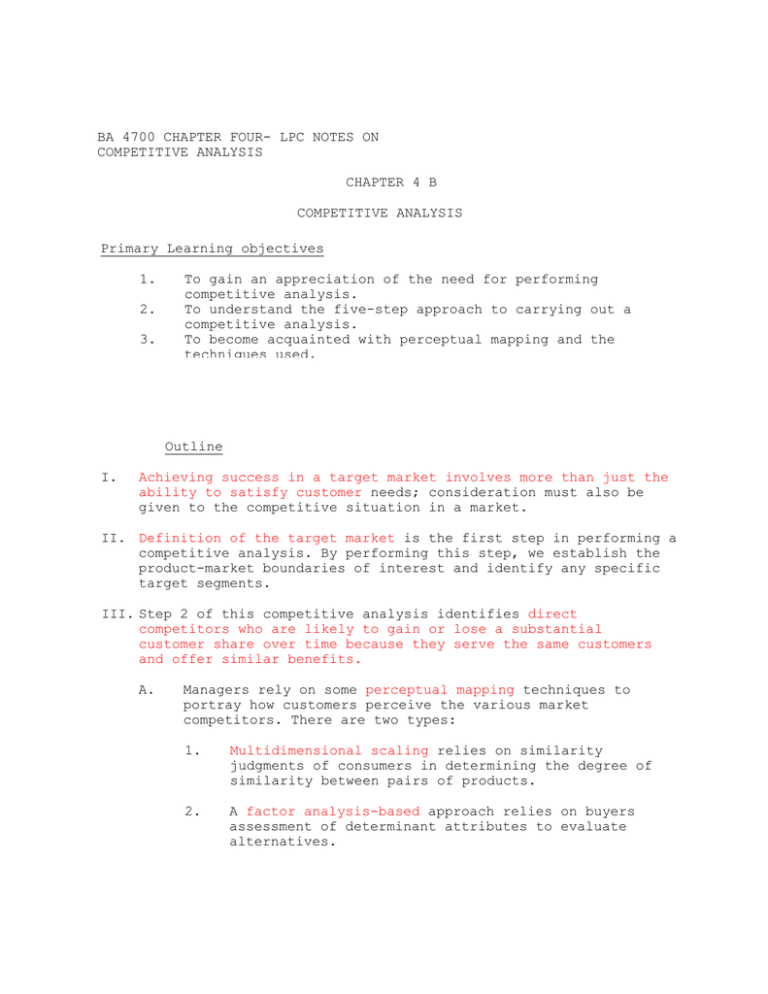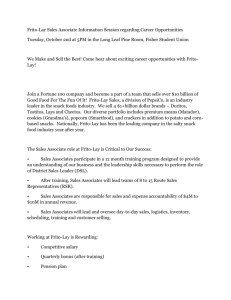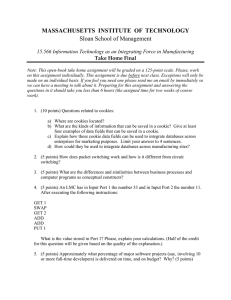4700c4lw+Mapping_1.doc
advertisement

BA 4700 CHAPTER FOUR- LPC NOTES ON COMPETITIVE ANALYSIS CHAPTER 4 B COMPETITIVE ANALYSIS Primary Learning objectives 1. 2. 3. 4. To gain an appreciation of the need for performing competitive analysis. To understand the five-step approach to carrying out a competitive analysis. To become acquainted with perceptual mapping and the techniques used. To gain an appreciation and awareness of sources of competitive intelligence. Outline I. Achieving success in a target market involves more than just the ability to satisfy customer needs; consideration must also be given to the competitive situation in a market. II. Definition of the target market is the first step in performing a competitive analysis. By performing this step, we establish the product-market boundaries of interest and identify any specific target segments. III. Step 2 of this competitive analysis identifies direct competitors who are likely to gain or lose a substantial customer share over time because they serve the same customers and offer similar benefits. A. Managers rely on some perceptual mapping techniques to portray how customers perceive the various market competitors. There are two types: 1. Multidimensional scaling relies on similarity judgments of consumers in determining the degree of similarity between pairs of products. 2. A factor analysis-based approach relies on buyers assessment of determinant attributes to evaluate alternatives. IV. Assessing competitive dynamics, step 3 of the competitive analysis, involves attempting to project what the future competitive environment will look like. A. 1. Pioneer products act as "prototypes" for competitors. 2. Initial brands potentially build significant loyalty. 3. Late entrants will have difficulty obtaining awareness and trail by distributors and consumers. B. If the future competitive structure of a market is to be understood, managers should attempt to determine the potential for technological discontinuity. C. Although the identity of current direct competitors is important, it is equally essential to identify future competitors, i.e., new entrants. D_ Barriers to entry make it difficult to become a significant competitor in a new market. E. V. Pioneering advantage is the market advantage that results from a competitor being the innovator in a market. Several factors contribute to this advantage: 1. Economies of scale, initial financial investment, lack of access to sources of production, and limited access to distribution channels are some typical barriers to entry. 2. Tariffs, quotas, customs, and governmental intervention are some international entry barriers. New entrants can cause considerable competitive concern through improved price performance trade-offs, by bringing new skills to the industry, or by virtue of cross-subsidizations. The importance of assessing competitive intensity, step 4, is twofold: to determine the likely cost of meeting competition and to recognize the most important bases and types of competition. A. Several basic conditions which foster intense competition are: numerous competitors, slow industry growth, undifferentiated products and services, low switching costs, significant economies of scale, industry overcapacity, and management loyalty. The ultimate purpose of performing a competitive analysis is to identify possible avenues for attaining a sustainable advantage over competitors so as to achieve product or product line objectives. A. In assessing competitive advantage, managers must identify the positions and sources of advantage that lead to desired market performance outcomes. 1. Positional advantages depend on the customer's perception of these advantages. 2. Source advantages include: skills of people within the organization, the systems or arrangement developed for market response, and the organization's resources. 3. Superior resources, intangible and tangible, can enable a firm to either underprice the competition or to offer better or unique performance. . Sources for obtaining competitive intelligence fall into three basic categories: published material and documents, competitors' employees, suppliers, or customers; and direct observation. THE BATTLE FOR THE COOKIE MARKET In 1982, marketers in the cookie industry received a doublebarreled attack with the-entrance of Procter & Gamble's Duncan Hines cookies and Frito-Lay's Grandma's brand. Initially, both lines were successfully test-marketed in Kansas City, and by 1983, Frito-Lay had begun moving into a variety of other markets. At the time of these entries, the cookie market had been stagnant. Unit sales had been declining since 1967, and per capita consumption had slipped from 11.9 pounds per capita in 1967 to 8.9 pounds per capita in 1982. However, because the industry was characterized by stable prices and low marketing expenditure levels, P&G and Frito-Lay were drawn to it because of its profit potential. (Industry leader Nabisco, with a 35 percent share, spent only $8 million in advertising in 1982, and the top three marketers spent a combined total of only $15 million.) The primary reasons for the decline in industry sales of packaged cookies were: a decline in the population of 5 to 13 year olds; increasing consumer concerns about nutrition; and emerging competition from fresh-baked cookie producers and from supermarkets' own in-store bakeries. However, marketing managers at Frito-Lay argued that the industry's problem was that cookies were "undermarketed." Specifically, low advertising levels, poor distribution in convenience outlets, and products with inferior taste qualities for the money when compared with fresh-baked products were all identified as factors which had limited growth. Frito-Lay initially entered the cookie market with Grandma's line, touting the fact that its products were soft and chewy, not hard and crunchy like other packaged cookies, and pricing them 20 percent above the competition. To distribute'the product, the company used its 10,000-person snack-foods sales force calling directly on 300,000 supermarkets, convenience stores, and small corner groceries to ensure maximum distribution. Additionally, the sales force restocks shelves at each store (at least three times per week) to ensure freshness and to avoid stockouts. The distribution system is essential to Frito-Lay because Grandma's have a much higher moisture content than other packaged cookies in order to maintain a fresher taste. The higher moisture content reduces the shelf life, however, necessitating the frequent stock replenishment available through Frito-Lay's "store door" distribution. By mid-1983, the advertising and sales promotional budget for Grandma's was estimated to be running at an annual rate of $70 million. P&G entered the cookie market shortly after Frito-Lay with a patented process for making cookies which are "crunchy on the outside, chewy on the inside," a brand name associated with quality baking, and a price which was competitive with most Nabisco brands. Unlike Frito-Lay, P&G distributes through grocery chain warehouses - a method which cuts selling costs and which is effective because of a longer (6 months) shelf life of the product. By late 1983, the Duncan Hines line had surpassed Grandma's in the Kansas City test market, and $30 million had been invested in the line. A national introduction was anticipated by 1984. As the new competition unfolded, the industry leaders began to react. Third-ranked Sunshine Biscuits initiated'its first national television campaign focusing on its Hydiox brand while downsizing nine of its sandwich-type cookie brands and pricing them below $1.00 (about 40 to 60 cents below most Nabisco's lines and 60 cents below Duncan Hines). Second-ranked Keebler moved aggressively into the West Coast - a market which was new to the company - and began a series of sweepstakes promotions and coupons. Half of Nabisco's 1982 domestic earnings came from its cookie and crackers line, and in 1983 the company moved to protect its position. A new line of "moist and chewy°,cookles (the "Almost Home" line) was lunched in about 10 percent of the country, $30 million was added to the advertising budget, and couponing was increased. Like Frito-Lay, Nabisco distributes-thrbugh a storedoor sales force. But with only 3000 salespeople, the company calls primarily on larger stores and supermarkets. Because of its tremendous volume, the use of efficient 300-foot ovens, and the fact that they mill their own flour and even make their own boxes, Nabisco had a significant cost advantage. Additionally, in early 1984 Nabisco management was known to be planning a major effort in the sack food market (in which Frito-Lay was the dominant firm).* 1. Summarize._the key factors that P&G and FritoLay identIIfied in their situation analyses that prompted their entry into the packaged cookie market. 2. Perform a competitive analysis of the packaged cookie market as of early 1984 and indicate the apparent key strengths and weaknesses of each competitor. THE BATTLE FOR THE COOKIE MARKET 1. Given the lack of growth in the packaged cookie market, the decision of P&G and Frito-Lay to enter to market seems somewhat surprising. However, while the lack of growth seems partly due to noncontrollable factors, there are some factors which make the market attractive: • Nabisco seems to be treating its cookie line as a cash cow, putting little advertising into the line. • Distribution is limited in convenience outlets (where Frito-Lay is strong). • A major reason for the decline is the rise of competition from the "fresh baked" product form. Both new entrants believe they can blunt this-competition through new products offering comparable (or superior) benefit. 2. Nabisco Frito-Lay P&G Product Attributes Moist & Chewy Moist & Chewy Moist & Chewy Advertising Low High High Distribution High Chains & Chains conven. Sales Force 5000 Store-door 10,000 Store-door Other Resources 300-Foot ovens Use existing mill own flour sales force commitment well financed Large (?) Lower selling cost well financed Nabisco is clearly using a retention strategy in which new products are being introduced to reduce the attractiveness of switching, and advertising is being expanded to match the competition. Frito-Lay entered with essentially a primary demand strategy--new benefits to match product form of competitors and broader availability (through convenience outlets). P&G's strategy will support Frito-Lay's primary demand efforts, but P&G seems to have a head-to,head acquisition strategy in mind to draw customers fromm Nabisco-competitive pricing, aggressive chain store 'distribution, heavy advertising. At the same time, P&G's line is crunchy and chewy--slightly different attributes than competitors have. However, it is not clear that consumers would view this difference as a trykyiunique attribute. Frito-Lay's original strategy at the selective demand level was to differentiate Grandma's from other packaged cookies, then out-advertise and out-convenience Nabisco. The key learning experience in this case comes from recognizing the dynamics in this market. Nabisco's reaction and P&G's entry will somewhat blunt Frito-Lay's initiative. Students should recognize that Nabisco's response was predictable: it is heavily committed to this market and has excellent technology. Also of note is the apparent attempt by Frito-Lay to avoid any price co4petition. Nabisco should have lower production costs, and PEG appears to have low selling costs. Finally, Nabisco's threatened entry into snacks can be viewed as an attempt to put more pressure on Frito-Lay's reserves.



